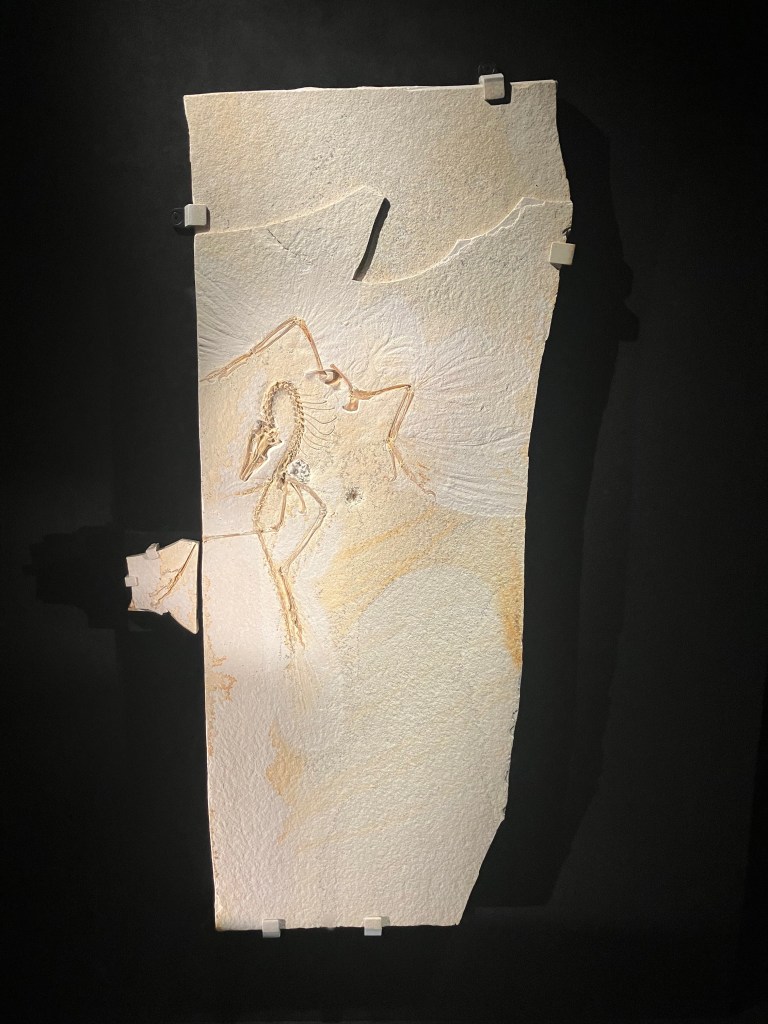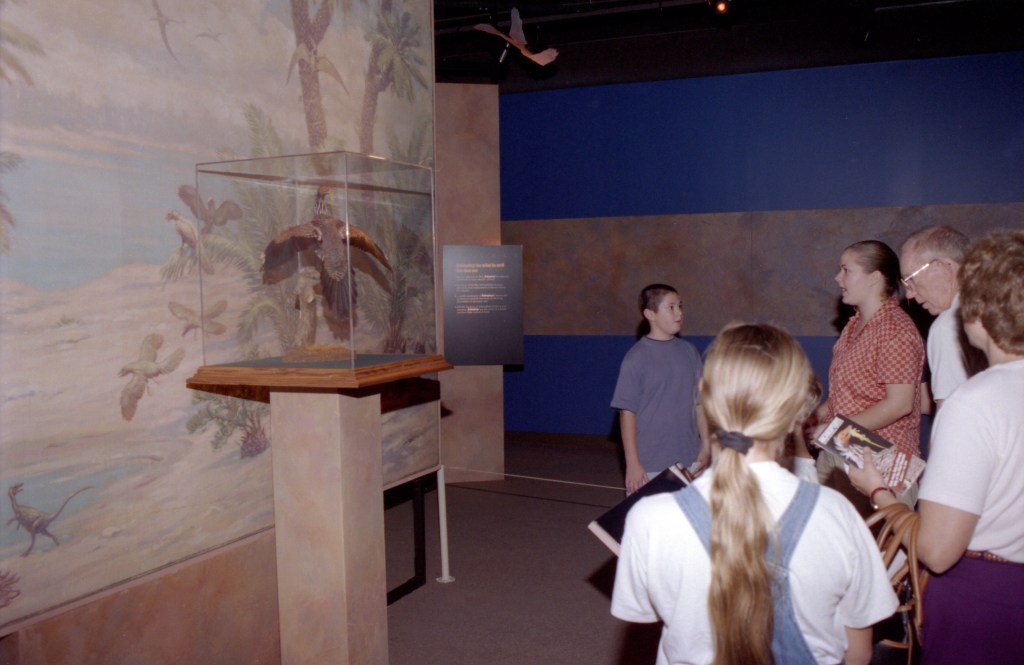
Earlier today, the Field Museum revealed the Chicago Archaeopteryx to the world. Named for the city it resides in (as is traditional for Archaeopteryx fossils), this is only the 13th specimen of this famous taxon yet discovered, and a contender for the best-preserved. The fossil is currently on display for a limited preview—it will return to collections for further research on June 9, and return as part of a larger, permanent exhibit toward the end of the year.
Archaeopteryx is famous for being the fossil that proved Darwin right. When he laid out his case for evolution by natural selection in On the Origin of Species (published in 1859), Darwin primarily relied on observations of living organisms, but predicted that transitional forms between groups should appear in the fossil record. Then, just two years later, the first Archaeopteryx fossil turned up—a reptile with feathers like a bird. Archaeopteryx has been synonymous with evolutionary science ever since, and it’s had its part to play as our understanding of the relationship between dinosaurs and living birds gradually solidified. Today, we know that Archaeopteryx was not the first feathered dinosaur, but it is the earliest known dinosaur to use its feathers for flight, rather than for insulation or display. Archaeopteryx fossils have proven stubbornly rare, however, so each individual specimen is celebrated.
The Chicago specimen is not, in fact, the first Archaeopteryx to be displayed at the Field Museum. For two weeks in 1997, the museum hosted a very limited engagement of the specimen now known as the Munich Archaeopteryx. The Munich specimen was found in August of 1992 and was the 7th individual to be discovered. Like all other Archaeopteryx fossils, it was collected in Bavaria, Germany in a spoil pile of Solnhofen limestone. Slabs of this rock have been used for centuries as roofing tiles and for lithographic printing. Indeed, the Munich Archaeopteryx was collected by Jürgen Hüttinger, a quarry worker employed by the Solenhofer Aktien-Verein stone company.
Aktien-Verein owned the quarry and thus, owned the fossil. The company contacted paleontologist and Archaeopteryx specialist Peter Wellnhofer, and loaned the fossil to the Munich Paleontological Museum for preparation and study. The Archaeopteryx was prepared by Ernst Schmieja under Wellnhofer’s supervision. It proved to be nearly complete, but only included the back part of the skull. Both the slab and counterslab were recovered—the skeleton is preserved in the slab but the feather impressions are more visible on the counterslab.

Aktien-Verein allowed the fossil to be displayed locally for several years, starting in 1993. But in 1997, plans materialized for the Archaeopteryx to take a little trip. Wellnhofer accompanied the fossil to Chicago so it could make an appearance at the 57th annual meeting of the Society of Vertebrate Paleontology (SVP), which the Field Museum was hosting that year. The fossil was on public display from October 4th through 19th, and Wellnhofer gave a public lecture on the 18th. While the visit was extremely short, it was also historic: this was the first time any Archaeopteryx fossil had ever left Europe. Many of the mostly North American paleontologists attending SVP that year had never seen an Archaeopteryx in person before.

The Exhibitions Department, for their part, went all-out in making the fossil’s brief visit special. The Archaeopteryx was displayed in a small gallery on the museum’s main level, past an impressive facade of angular blocks that recall slabs of Solnhofen limestone. The exhibit was officially titled “Archaeopteryx: The Bird that Rocked the World,” but only the name Archaeopteryx appeared over the entryway.
Once inside the darkened space, visitors could immediately inspect the slab and counterslab, which were mounted under a vitrine on an angled platform. Visible through the fossil case was Charles Knight’s Solnhofen mural from the 1920s, which was brought out of storage for this exhibit. Cases to the right and left contained small Solnhofen fish fossils and casts of Compsognathas and the Eichstätt Archaeopteryx.

Another highlight was a new life-sized model of Archaeopteryx, created by Milwaukee Public Museum taxidermist (and accomplished falconer) Greg Septon. This Frankenstein-like creation was assembled from pelts and feathers from seven bird species, including a cormorant and a partridge. The teeth were sourced from a rainbow trout.
Referencing the bird’s German origin and leaning into it’s difficult-to-pronounce name, the museum held a family event on October 18 entitled “Archaeoptoberfest.” Kids could make kites, see other bird specimens, and hear the story of Icarus (really) under the feet of Ernestine the Brachiosaurus.
The brief visit to the Field Museum was the Munich Archaeopteryx‘s only time leaving Germany. Two years later, the Munich Paleontological Museum assembled the funding (nearly 2 million marks) to purchase it from Aktien-Verein. Today, it remains part of the Bavarian state collection and is on display in Munich.
Unlike the Munich specimen, the Chicago Archaeopteryx is a permanent addition to the Field Museum’s collection. You can learn more about its journey so far in Patti Wetli’s in-depth reporting for WTTW. Come see it before June 9 if you can!
References
Archaeopteryx: The Bird that Rocked the World. Earth Science News October 1997.
A rare bird indeed will visit Field Museum. Chicago Tribune Sep 30, 1997.
Maes, N. Rare bird fossil has a Field day. Chicago Tribune October 3, 1997.


E
Extreme bragging rights with this!
All we need now is an ankylosaur
They can be rare.
Did Greg Septon do the Archaeopteryx at the Milwaukee Public Museum as well? I know that one was created with the feathers from numerous extant birds too. I’ve seen both models dozens of times, but never put them together. Are they exactly the same?
I don’t know for sure, but that’s worth checking into!
I assume both of the MPM Archaeopteryx models (in Third Planet and Rainforest) were made in the 80s, same as the rest of those exhibits.
Oh! I forgot about the one in the Rainforest! I was digging through my photos to see if I had an image to compare, but I guess I haven’t taken any pics of any Archaeopteryxes, at least in the last 12 years.